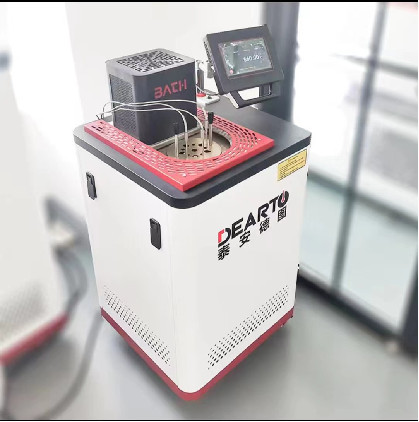Low & High Temperature Calibration Bath
A New Generation of Intelligent Constant Temperature Equipment
Liquid Calibration Bath Series Product Selection Table
| Product number | DTS-CT300G | DTS-CT95G | DTS-CT01G | DTS-CT10G |
|---|---|---|---|---|
| Temperature range (°C) | 70 ~ 300 | RT+10 ~ 95 | 0 ~ 100 | -10 ~ 100 |
| Fluctuation (℃/10min) | ±0.007 | ±0.01 | ±0.01 | ±0.01 |
| Uniformity(℃)) | ≤0.01 | ≤0.01 | ≤0.01 | ≤0.01 |
| Working medium | L30-300 | deionized water | L15N-95-R | |
| Volume(L) | 23 | 18.5 | 18.5 | 18.5 |
| Work area size(mm) | Φ150×480 | Φ130×480 | ||
| Dimensions(mm) | 660(L)×540(W)×1120(H) | |||
| Intelligent Low Temperature Calibration Bath | ||||
| Product number | DTS-CT30G | DTS-CT40G | DTS-CT60G | DTS-CT80G |
| Temperature range (°C) | -30~100 | -40~100 | -60~100 | -80 ~ 100 |
| Fluctuation (℃/10min) | ±0.01 | ±0.01 | ±0.01 | ±0.01 |
| Uniformity(℃)) | ≤0.01 | ≤0.01 | ≤0.01 | ≤0.01 |
| Working medium | L35N-95-R | L45N-95-R | L100N-20 | |
| Volume(L) | 18.5 | 18.5 | ||
| Work area size(mm) | Φ130×480 | Φ130×480 | ||
| Dimensions(mm) | 660(L)×540(W)×1120(H) | 700(L)×590(W)×1120(H) | ||
Triple Point of Water Maintenance Bath
| Product numbe | DTF-CT01SG | DTF-CT30SG | DTF-01SG | DTF-30SG | DTF-01G |
|---|---|---|---|---|---|
| Temperature range (°C) | -10~105 | -30~105 | -10~100 | -30~100 | -10~100 |
| Way to control | Intelligent Screen Control | Precision Instrument Control | Regular Control | ||
| Product type | One bath for three purposes (a water triple point cell freezer, water triple point cell storage unit, and refrigerated temperature bath) | Standard type | |||
| Fluctuation (℃/30min) | ±0.005 | ||||
| Uniformity(℃)) | ≤0.01 | ||||
| Working medium | L35N-95-R | ||||
| Frozen quantity (branches) | 1~3 | ||||
| Dimensions (mm) | 660(L)×540(W)×1120(H) | ||||
Calibration Bath: Guide
Commonly used media for calibration baths are water, silicone oil, antifreeze, absolute ethanol, tin, salt, etc., which respectively constitute alcohol low-temperature calibration baths, water baths, oil baths, high-temperature tin baths, and high-temperature salt baths.
1. What Is a Temperature Bath For Calibration?
A temperature calibration bath is a calibrator having a uniform fluid enclosure that can be adjusted to specific temperatures for test points. They offer large volume and flexibility for calibrating temperature sensors that are different shapes and sizes.

2. What is the Temperature Range of a Bath Calibrator?
3. How Do You Check Temperature Calibration?
4. What is a Temperature Bath Used For?
5. Why Do We Use Kerosene In Low Temperature Calibration Bath?
While kerosene was once commonly used in low-temperature calibration baths, its use has largely been replaced by other fluids due to safety concerns and environmental considerations. However, it's still helpful to understand why kerosene was initially preferred and what its limitations are.
Why kerosene was used:
Wide liquid range: Kerosene remains liquid across a relatively wide temperature range, from around -40°C to 250°C. This allowed for a single fluid to be used for calibrating instruments across a broad spectrum of low temperatures.
Good heat transfer: Kerosene has decent thermal conductivity, meaning it efficiently transfers heat to the instruments being calibrated, ensuring accurate and consistent temperature readings.
Readily available: Kerosene was historically a readily available and relatively inexpensive fluid, making it a practical choice for calibration baths.
Limitations of kerosene:
Safety hazards: Kerosene is a flammable liquid with a flash point around 38°C. This poses a significant fire risk, especially in enclosed laboratory settings.
Environmental concerns: Kerosene is a petroleum-based product, and its use and disposal raise environmental concerns. Spills can contaminate soil and water, and improper disposal can contribute to air pollution.
Health risks: Kerosene vapors can be harmful if inhaled, and prolonged exposure can irritate the skin and eyes.
Modern alternatives:
Silicone oils: These synthetic oils offer a wider temperature range than kerosene, typically from -70°C to 200°C, while being non-flammable and much less harmful to the environment.
Glycols: Certain glycol-based fluids, like ethylene glycol, are also suitable for low-temperature calibration baths, with good thermal properties and non-flammability.
Alcohol mixtures: For even lower temperatures, mixtures of alcohols like ethanol and methanol can be used, reaching down to -90°C. However, they require special precautions due to their high flammability.
6. High Temperature Calibration Bath Vs Low Temperature Calibration Bath
| Feature | High-Temperature Baths | Low-Temperature Baths |
|---|---|---|
| Temperature Range | Typically above 300°C | Typically from -80°C to 200°C |
| Fluid Choices | Molten salts, molten metals, high-temperature oils | Silicone oils, ethylene glycol, alcohol mixtures |
| Construction Materials | Stainless steel, ceramics, refractory materials | Stainless steel, aluminum, plastic |
| Applications | Aerospace, metallurgy, chemical processing, energy production | Pharmaceutical research, cryogenic testing, food processing, environmental monitoring |
| Safety Considerations | Strict | Lower |
| Selection | Consider temperature range, instrument compatibility, safety requirements, budget, environmental impact | Consider temperature range, instrument compatibility, safety requirements, budget, environmental impact |



